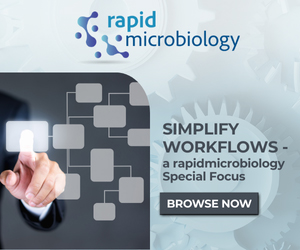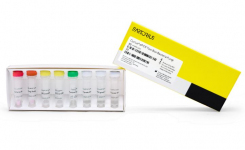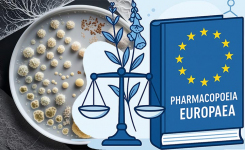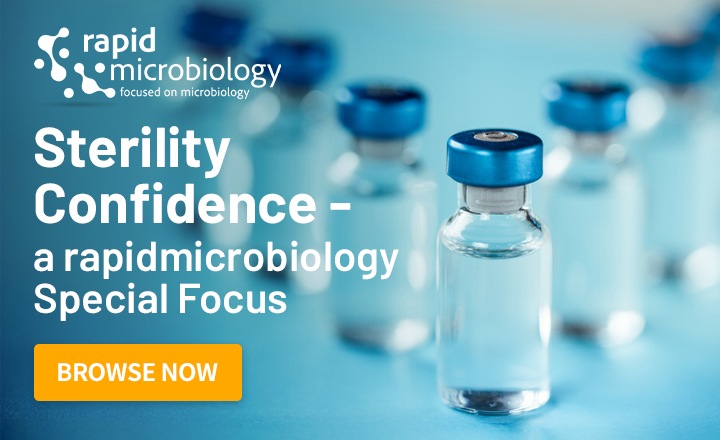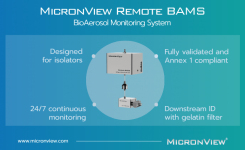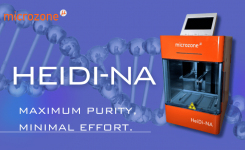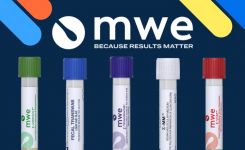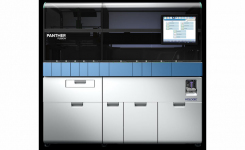
An Introduction to RMM for Bioburden Testing by Marcel Goverde, MGP Consulting GmbH, Switzerland
According to the FDA Guidance for Industry (2004), bioburden is defined as follows: "The total number of microorganisms associated with a specific item prior to sterilization."
Another definition of bioburden is given by EudraLex (2010) and PIC (2007): "The level and type (e.g. objectionable or not) of microorganisms that can be present in raw materials, API starting materials, intermediates or APIs. Bioburden should not be considered contamination unless the levels have been exceeded or defined objectionable organisms have been detected."
The bioburden test in general is often seen as the test which is performed on the bulk solution used for parenteral products, either manufactured aseptically or terminally sterilized. The methods used are membrane filtration, plate count method or MPN according to Ph. Eur. 2.6.12 or USP . By definition these methods are regarded as validated by the pharmacopeia. Whenever a different method is applied, it is advisable to validate this method according to Ph. Eur. 5.1.6., USP or PDA TR No. 33 (2013) and to show equivalence to the pharmacopeial method. Such validations for alternative or rapid microbiological methods (RMM) are available and are performed either by the supplier or some pharmaceutical companies.
However, each company that applies its own RMM should validate the method for its intended purpose. Since several applications are available on the market, a number of RMMs are presented in the following paragraph that can be used for bioburden testing without the claim of being exhaustive.
One of the basic questions when evaluating a RMM for bioburden testing is the limit of detection needed. An acceptance criterion of 10 cfu/100 ml is often used for the bioburden for parenteral products (EMEA 1996), however, it can be higher, as in biotech APIs, and then other methods with a less sensitive limit of detection can be used.
Possible RMMs for Bioburden Testing
- Automated detection of growth: Normally growth is detected by incubating agar plates for 3-7 days and then assessing microbial growth by the human eye. Thus using an approach by which the microbial growth can be detected earlier is a good alternative and validation work is less complicated. Several such approaches are available on the market and are described below. For fully automated, traceable counting of colonies, bioMerieux's EviSight Compact incubates plates in a smart incubator taking high resolution pictures every 30 minutes, specific algorithms detect any growth as it occurs and reported results include the growth curve and last image of the plate.
- Staining: Filterable products are processed as with the compendial method but after incubation (normally for a shorter time than samples evaluated by the human eye) they are stained with CFDA (carboxyfluorescein diacetate), which is a non-fluorescent substrate. Within the cell the CFDA is cleaved to carboxyfluorescein which can be detected by the Millipore Milliflex® Quantum system earlier than colonies can be detected by the human eye. As for the compendial method, the limit of detection is 1 cfu and identification of the isolate is possible. This system has been validated and this validation will be published by the end of 2016 (Goverde et al. in prep.).
- Autofluorescence I: The autofluorescence of microorganisms can be detected in real time using a laser (normally of 405 nm), such as IMD-WTM by BioVigilant. Such systems work with water samples; however, how they work with products is not known to the author. The instrument can be used as an online system, i.e. no growth step is needed. The limit of detection is 1 cfu, however, the cfu is not growth-based, and not only growing species are detected but also the VBNC (viable but non-cultivable). Thus the challenge is the correlation between the counts of the system and the cfu of the compendial method. Identification of the isolate should be possible if the tested solution is caught.
- Autofluorescence II: Another system where microorganisms are detected by their autofluorescence is the Growth Direct™ (RapidBioMicrosystem). After filtration of the product, the plates are incubated. The system then automatically makes regular checks for microbial growth (e.g. every 4 hours). Thus the bioburden is detected earlier than with the traditional method (read-out by the human eye). Such a system makes validation work easier as, generally speaking, the same is done as for the compendial method and only the read-out is performed by the system. Additionally this system is fully automated and can be linked to a LIMS system. Limit of detection is 1 cfu; identification of the isolate is possible.
- ATP-Bioluminescence: ATP is a general marker of cell viability and is therefore present in each living cell. The product is filtered, placed on an agar plate and incubated as for the compendial method. After a validated incubation time, the cells are lysed and the ATP can be detected, e.g. using the Milliflex® Rapid system (Merck Millipore). Thus a real cfu count is found. However, the challenge of such a system is to detect or correctly count slow-growing microorganisms when fast growers are also present. It might not be possible to count the cfu since the light emitted by the fast grower will be too strong for a read-out. The limit of detection with this method is 1 cfu; normally an incubation step of 24-72 hour is needed. Identification of the contaminants is possible although it is a destructive method (Gray et al. 2011).
- Cytometry: Flow cytometry can be used for bioburden such as bioMérieux's Scan®RDI (which uses laser cytometry technology), especially when the acceptance criteria are high. For cytometry the microorganism are fluorophore-labelled and then counted by the system. Flow and solid cytometry are both near real-time detection. Flow cytometry is very convenient but its limit of detection is app. 100-1000 cfu. Solid phase cytometry has a 1 cfu limit of detection but this method is time consuming and identification is not possible.
- Endotoxin: Finally, bulk solution testing for Endotoxin is being increasingly requested since potentially gram-negative bacteria could be present and produce endotoxins. The traditional methods are already quite fast but must be performed in a laboratory. Charles River has developed a handheld device (Endosafe®-PTS™) that can be used directly at the point of use. Results are available within 15 minutes. Visit our Endotoxin Test Method Guide.
Validation needed Some of the above methods are easier to validate for routine use than others. The Endosafe®-PTSTM, for example, uses the same reagents as the compendial methods. There are some aspects (e.g. the archived standard curve) that need validation work, but much less than when using a compendial system such as ATP detection. Furthermore, if the methods are used for in-process control or trouble shooting, validation work can be reduced.
In summary, each method must be critically evaluated by the user to see if it suits his needs and what level of validation work is involved. These methods are very attractive and can help to reduce workload but the investment must be calculated beforehand.
References EMEA 1996, Committee for Proprietary Medicinal Products (CPMP), Note for Guidance on Manufacture of the Finished Dosage Form, CPMP/QWP/486/95. EudraLex (2010). The Rules Governing Medicinal Products in the European Union. Volume 4. Good Manufacturing Practice. Medicinal Products for Human and Veterinary Use. Part II: Basic Requirements for Active Substances used as Starting Materials. FDA (2004). Guidance for Industry – Sterile Products Produced by Aseptic Processing – Current Manufacturing Practice. PDA (2013). Technical Report No. 33. Evaluation, Validation and Implementation of Alternative and Rapid Microbiological Methods. Goverde M., Staerk A., Roesti D. (in prep.). Validation of the Millipore Milliflex® Quantum for Bioburden testing of Pharmaceutical Bulk Solutions. Gray J.C., Morandell D., Gapp G., Le Goff N., Neuhaus G., Staerk A. (2011). Identification of Microorganisms after Milliflex Rapid Detection - A Possibility to Identify Nonsterile Findings in the Milliflex Rapid Sterility Test. PDA Journal of Pharmaceutical Science and Technology, 65(1), pp. 42-54. Ph. Eur. chapter 2.6.7 (current version). Mycoplasmas. Ph. Eur., chapter 2.6.12. (current version). Microbiological examination of non-sterile products: microbial enumeration tests. Ph. Eur., chapter 5.1.6. (current version). Alternative methods for control of microbiological quality. PIC/S (2007). Guide to good manufacturing practice for medical products. Pharmaceutical Inspection Co-operation Scheme, PE 099-06 (Part II). USP, chapter (current version). Validation of alternative microbiological methods. USP, chapter (current version). Microbiological examination of nonsterile products: microbial enumeration tests.
About the author: Marcel studied biology at the University of Basel, where he gained his PhD in 2001. Gathered first work experience as scientific collaborator in the agro biological section of Novartis. Development project in Costa Rica and teaching at different school levels. From 2002-2010 he led several QC labs for microbiology at F. Hoffmann-La Roche Ltd. From 2010-2011 he worked as a QC expert for microbiology at Novartis Pharma Ltd. Since 2011 he has been running his own business for consulting, training, project and deviation management named MGP Consulting GmbH. Marcel is a regular speaker at different institutions and has written several scientific papers. He is the Swiss expert in the EDQM group for modern microbiological methods since 2003 which was integrated into Group 1 (Microbiological Methods and Statistical Analysis) in 2015. Marcel is deputy chair of the ECA Pharmaceutical Microbiology Working Group and holds a green belt in Lean Six Sigma.
Recent Developments:
Enhanced Fluorescence: Another system where microorganisms are detected by fluorescence, is the MICA Bioburden solution by DIAMIDEX. After filtration of the product, the plates are incubated in presence of a modified metabolite that will be incorporated into macromolecules present on the cell surface of all growing microorganisms. At the desired time of incubation (depending on the plates used), the microcolonies are revealed thanks to a fluorescent probe that will be clicked to the cell surface. Therefore, the enhanced/amplified fluorescence will allow the detection of a microcolony at a very early stage using a machine learning algorithm included in the MICA equipment. Additionally, MICA Bioburden which has a limit of detection of 1 CFU can be linked to a LIMS system (Source: Diamidex)





